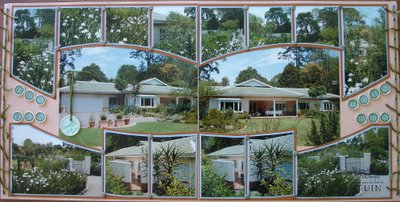 HOME SWEET HOME
HOME SWEET HOME
Conroy and me have been quite busy making this house in Kloof, Durban our own sanctuary for the past 4 years. Our garden was a blank canvas in 2002. We are both nature lovers and on the advice of our landscaper, Jason de Leur, we went the indigenous route. Today we are benefitting from this choice. It is not only a waterwise garden, the birdlife is absolutely amazing. With all the rockeries incorporated the reptile species has also made it their home. A bee colony also zoom-ed in and unfortunately we were forced to have them professionally removed for safety reasons. The local Kloof monkey troops also frequent the garden in search of tasty morsels (being anything that flowers) and entertains us with their clowning around.
We often forget to take photos of our homes and as we move on the memories of our past homes fade. Having done this scrapbooking layout I knew that we will always have a visual memory of this house we made our home.
The white irises were in full bloom one sunny afternoon and I had to take the opportunity of capturing them. The specks of white from the irises formed a nice frame around the photos of our home.
Below is a brief history of our indigenous garden, our vision for it, etc.
Brief History of the Garden
We relocated from Pretoria to Kloof, Durban during January 2002. Unit 4, 4 Coghill Ave was a spec house at the time. There was no garden and no retaining walls around the back and side of the house. Due to seasonal heavy rains the unretained embankments around the house posed a serious mudslide threat.
We appointed a local landscaper to solve this problem and do the basic shaping/landscaping of the garden. On recommendation from the landscaper we decided to go the indigenous route. We have had no previous knowledge or experience regarding indigenous plants and gave the landscaper carte blanche with regard to the type of plants he introduced.
A year lapsed after the initial landscaping and numerous plants and ground covers seemed very messy/scraggy and just not our style. The embankment on the one side of the house was still causing mudslides during heavy rain and we struggled to keep the flagstone path, which we have in the meantime laid ourselves, free from soil.
Having been to the Kloof Conservancy/Robyndale open gardens day during 2003 we got inspired by some of the gardens and decided to approach Robyndale for suggestions and a quote. After Jason de Leur took us on a tour of indigenous gardens they landscaped, we fell in love with how natural the gardens looked and blended in with the local environment.
Robyndale commenced, during July/August 2003, with the FIRST PHASE of the garden. They removed 80% of the previous landscaping and started with a clean canvass. The problem embankment on the side of the house and the front garden as well as the steps up to the swing bench above the rockery at the side of the house was their first challenge – which turned out to be the key elements of the garden.
The SECOND PHASE (the rest of the embankment in front of the swing bench area and the back of the house) was re‑landscaped during July 2004.
The THIRD AND FINAL PHASE (removal of Yesterday-Todays-&-Tomorrow’s in front of boundary wall and relandscaping) was done during July/August 2004. This area is therefore the youngest area in the garden and has grown tremendously in the 7 months since landscaping.
Vision
A luscious indigenous oasis where man, birds and animals can feel free to roam and live side by side. The garden is already a place in which tired souls can unwind and find new inspiration.
Particular Areas of Interest
The rockery with pathway leading to relaxation area and elevated viewpoint serves as a relaxing hideaway.
The flagstone path around the back of the house facilitates a peaceful walkabout whilst savouring the variety of indigenous plants which lines the pathway.
The various stone bird baths attract a variety of birds and gives a cool feeling on hot sunny days.
There are in the region of 14 species of aloes throughout the garden.
Wildlife
The blueheaded lizard and various other types of lizards live around the rockeries and stone water baths. As yet we have not spotted Chameleons and cannot wait for them to make this garden their home.
The local monkey troop makes its way through the garden once a week, foraging for quick and tasty pickings, the unopened Strelitzia flowers being a favourite.
Tree frogs are often spotted on windows during night time.
The following birds have been observed:
Woollynecked Stork (Wolnekooievaar)
Brownhooded Kingfisher (Bruinkopvisvanger)
Hoopoe
Purplecrested Lourie (Bloukuifloerie)
Bronze Mannikin (Gewone Fret)
Sunbirds
Redeyed Dove
Blackeyed Bulbul (Tiptol)
Olive Thrush (Olyflyster)
Black Flycatcher (Swartvlieëvanger)
Cape Wagtail (Gewone Kwikkie)
Hadeda Ibis
Egyptian Goose (Kolgans)
Watch this space for exciting scrapbooking layouts of our garden.!

This was fun reading about your house tec, I so wish to have a glorious garden like yours someday. Keep up the hard work, it pays off well!!!
ReplyDeleteThanks. Trust the family will also find it interesting - although they will probably moan about the English and perhaps wonder whether the Boer-tjie has become a 'Soutie'
ReplyDeleteHehehe, now that's funny! I think they will be happy regardless to read some nice news from you! Enjoy teaching tonight.
ReplyDeleteThis is totally awesome. You are a real magician at work. I am sure that alot of people will agree with me when i say that you are truly talented and inspirational. Can't wait for my class in March. And the garden looks stunning as well. TANIE
ReplyDeleteGlad you had a peep at my blog. I gather that you are also creative.
ReplyDeleteDesire